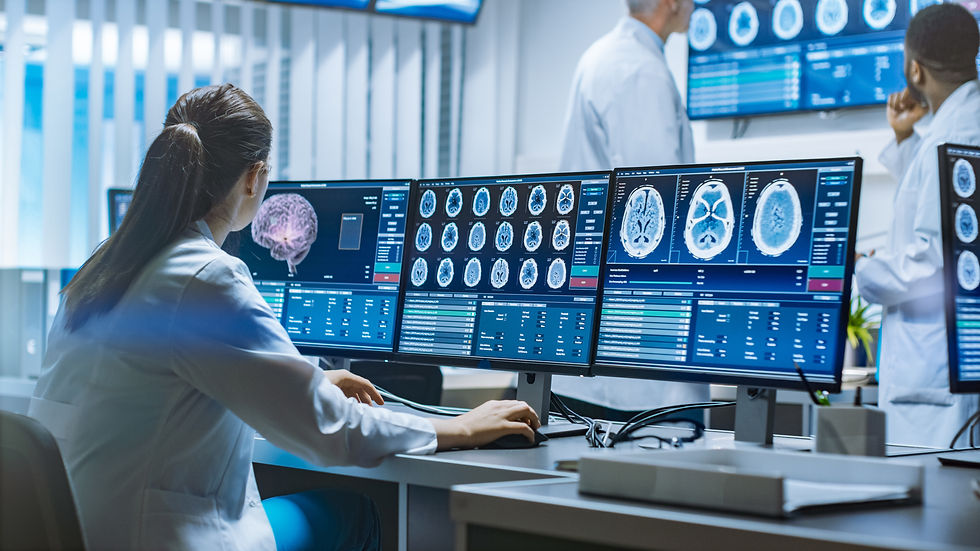Electroencephalogram (EEG)
- integrasmweb
- Mar 14, 2022
- 3 min read
Difference between electroencephalography and electroencephalogram
What is an electroencephalogram used for? How is it recorded?
What type of electrodes are used in EEG?
How many electrodes are generally used in EEG?
What is a normal EEG reading?
What does ‘abnormalities’ on an EEG mean?
What conditions can an EEG diagnose?
Can EEG detect mental illness?
Does an EEG show past seizures?
Can EEG detect anxiety?
How accurate is an EEG?
First, is there a difference between electroencephalography and electroencephalogram?
Is there a difference between electroencephalography and electroencephalogram?
The main difference is that an electroencephalogram is (neurology) a recording of electrical brain activity (brain waves) made by an electroencephalograph while electroencephalography is (neurology) the measurement and recording of electrical activity in the brain for diagnostic purposes.
What is an electroencephalogram used for? How is it recorded?
An electroencephalogram (EEG) is a test that detects electrical activity in your brain using small, metal discs (electrodes) attached to your scalp. Your brain cells communicate via electrical impulses and are active all the time, even when you're asleep. This activity shows up as wavy lines on an EEG recording.
What type of electrodes are used in EEG?
More in detail, EEG electrodes are produced with the shape of a cup, disc or needle, and are usually made of silver (Ag) and silver chloride (AgCl) [29]. Because Ag is a slightly soluble salt, AgCl quickly saturates and comes to equilibrium. Therefore, Ag is a good metal for metallic skin-surface electrodes [30].
How many electrodes are generally used in EEG?
Typically EEG systems with 64 or more electrodes are used. However, in practical applications, set-ups with fewer electrodes are required. Here, we determine the optimal number of electrodes, and the best position to place a limited number of electrodes on the scalp.
What is a normal EEG reading?
Most waves of 8 Hz and higher frequencies are normal findings in the EEG of an awake adult. Waves with a frequency of 7 Hz or less often are classified as abnormal in awake adults, although they normally can be seen in children or in adults who are asleep.
How do you know if your EEG is abnormal?
Even someone who has seizures every week can have a normal EEG test. This is because the EEG only shows brain activity during the time of the test. If you aren't having a seizure at that time, there may not be any unusual brain waves for the test to record. During a seizure, the electrical activity is abnormal.
What conditions can an EEG diagnose?
An electroencephalogram (EEG) is a noninvasive test that records electrical patterns in your brain. The test is used to help diagnose conditions such as seizures, epilepsy, head injuries, dizziness, headaches, brain tumors, and sleeping problems. It can also be used to confirm brain death.
So, can EEG detect mental illness?
Electroencephalography or EEG, technology that measures brain function could encourage earlier diagnoses of common mental and neurological disorders, including autism, ADHD, and dementia according to findings published in The Neurodiagnostic Journal.
Does an EEG show past seizures?
You may have had seizures in the past, such as brief absence seizures or auras, without knowing they were seizures. Doing an electroencephalogram (EEG), especially after sleep deprivation, may reveal abnormalities in the brain's electrical activity that may help confirm the diagnosis of epilepsy.
Can EEG detect anxiety?
Our experience shows us that the level of anxiety states can be classified from brain activity during the neural feedback experiment. With the help of our designed neurofeedback system, we can predict and classify anxiety states by collecting electroencephalography data of subjects.
In conclusion: How accurate is an EEG?
Can an EEG be wrong?
Yes, EEG can be bad for you. The consequences of being misdiagnosed with epilepsy are obvious and serious [9]. When the diagnosis is based largely on an abnormal EEG, no amount of subsequent normal EEGs will 'cancel' the previous abnormal one, and the wrong diagnosis is very difficult to undo.
Can an EEG give a false positive?
EEG will be negative in a large portion of patients with epilepsy and may be positive in patients without epilepsy. False-positive EEG findings commonly lead to unnecessary use of antiepileptic drugs and may delay the syncope diagnosis and treatment.
Can an abnormal EEG mean nothing?
An abnormal EEG doesn't automatically mean that you, for example, have epilepsy. The EEGs of babies and young children can often record irregular patterns that don't mean anything, or the irregularities may flag previously diagnosed neurological conditions such as cerebral palsy.
Can an EEG Miss seizures?
An EEG can usually show if you are having a seizure at the time of the test, but it can't show what happens to your brain at any other time. So even though your test results might not show any unusual activity it does not rule out having epilepsy.







Comments